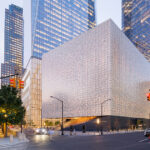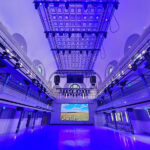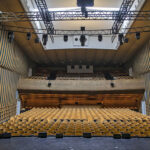The BCEC Gets a Dramatic Visual Update, Inside and Out
When the Boston Convention and Exhibition Center (BCEC) was first designed in the 1990s, the design called for exterior features that would change the Boston skyline and interior displays that would impress attendees not just with aesthetics but with practical — and revenue-generating — communications capabilities.Time and money constraints forced those ambitions on the back burner. Fast forward to late 2009, and the subject of the displays was again raised. Fortunately, the convention center was built to accommodate the displays, even though the designers and builders knew at the time of construction (2004) that those plans wouldn’t be fulfilled right away.
With the structural equivalent of a framed, blank canvas and a variety of technological advances available to them, BCEC, design firm Utile and technology consulting firm Sensory Interactive helped bring the convention center’s long-delayed visionary ideas to fruition, both inside and out.
The Interior Display
The concept for making the best use of the 12-by-160-foot display area greeting visitors as they enter the main lobby of the Convention Center was simple: Take the banners that trade show managers put up at the entrance of every tradeshow, enlarge them, and make them dynamic, useful and visually exciting, customized with information about the event at hand.
The sheer size of the display presented some communication challenges, however. At 160 feet, and with lots of potential information to be conveyed, the display needed to be designed with a visual focal point, and not require viewers to stand around for minutes at a time to get the information they need.
The BCEC and Sensory Interactive decided to incorporate a combination of display technologies provided by Daktronics, Inc. The center 50 feet of the display is composed of a high-resolution panel-based LED video display with a 10mm pixel pitch. This area provides a space where sharply focused images, full-motion video and text can be displayed to convey any desired message to a given audience.
On either side of this 10mm screen is a 55-foot wide area of 160 16mm LED video sticks, with a gradation in density: the first stick abuts the 10mm display; the last two sticks are more than 6.5 inches apart. The resulting display produces broad-stroke, ambient animation on each side to help direct the audience’s attention to the center of the display.
 The Outside Tower
The Outside Tower
In the late 1990s, the outdoor “Media Tower” was conceived as a large glass column that would house several smaller displays. Since then, technology — and the array of visual options — has expanded considerably.
Again with the help of Sensory Interactive, Utile, and a structural engineering assist from Simpson Gumpertz & Heger (SGH), the team came up with a three-sided display rising 76 feet in the air with three different technologies fused into a seamless, single piece of equipment.
The largest component of the tower is comprised of 16mm Daktronics LED video sticks in a formation that spans 44 feet in width and is 54 feet tall, wrapping three sides of the steel superstructure. Given the height and resolution of the sticks, images and messaging can be viewed with ease from distances of up to one half mile away.
Below the sticks are two high-resolution 16mm Daktronics LED video displays, each measuring 14 by 31 feet. In a horizontal configuration, they sandwich the east and west sides of the tower. These higher-resolution displays easily communicate site-specific information, such as parking and event schedules, that can be seen and read at distances up to 300 feet away.
A third component of the system is a series of Color Kinetics fixtures that light the supporting structure of the piece, which was designed by Boston-based LAM Partners.. The entire display sits on a series of 20-foot high columns. The video sticks are approximately 2 inches apart, so that, depending on the angle of approach, the upper portion of the display becomes almost transparent.
Because of this transparency, the fixtures placed within the support structure cause the entire display to glow from the inside out. Sensory Interactive worked with the engineering and creative teams at Daktronics to ensure that the various components of the Media Tower — including the higher-resolution video display modules and the lower-resolution video sticks — would work together as a cohesive whole.
To link the various Media Tower elements, and to link the exterior visuals also with the interior display, Daktronics media players work with Sensory Interactive’s content templates. A Pharos LPCX controller, which takes a video input signal from a video splitter in the Daktronics system, is another element within the integrated control system.
For now, Sensory Interactive is supporting the visuals on an ongoing basis with a staff member who serves as director of digital media. In time, those duties will be handed off to the BCEC’s governing entity, the Massachusetts Convention Center Authority.


